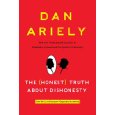We Are All Dishonest
October 30, 2012
I just finished Dan Ariely’s book on honesty – “The (Honest) Truth About Dishonesty,” – and while I admit that it could make you feel a bit uncomfortable about trusting anyone, it may be an exercise in proving the obvious.
Ariely is among a group of behavioral economists who try to prove, or disprove, theories based on scientific experimentation. The combination does not always produce the kind of clear conclusions you might like, but his writing is entertaining, comprehensible and always interesting.
Basically he concludes that everyone is corruptable given the right circumstances. The trick is to keep the circumstances to a minimum and take precautions. But then, anyone who has ever filled out a tax return, probably knows that.
My favorite section includes his admonition on the slippery slope that even small rationalizations can create. His insights involving politicians, or CEO’s who claim that they are not influenced by small ‘inconsequential’ lapses in moral standards, is particularly revealing. His observation is best summed up by Queen Gertrude in Hamlet, “Methinks the lady doth protest too much.” A free lunch from a lobbyist may be minor, but it’s probably just the tip of the iceberg.
I do have a couple of reservations about Ariely’s methodology. First, it is largely based on experiments with college students and even he tacitly admits this group may not be representative of the general population.
Second, you have to accept some of his underlying assumptions about what drives human behavior, to trust his conclusions. For example, in discussing medical treatment and evaluating whether true need or profitability is the true driver, he cites dentists who recommend more expensive enamel fillings when less-expensive mercury will do. That enamel is the more expensive option proves the dentist are motivated by greed, Areily claims, since they recommend that option more frequently than mercury.
He may be right, but I think he uses a bad example, because there is more to the enamel vs. mercury debate than just appearance. There is also a safety issue.
But, all in all, it certainly is worth taking a look at Ariely’s work, so you will understand why you, and everyone else, can’t help being dishonest.
